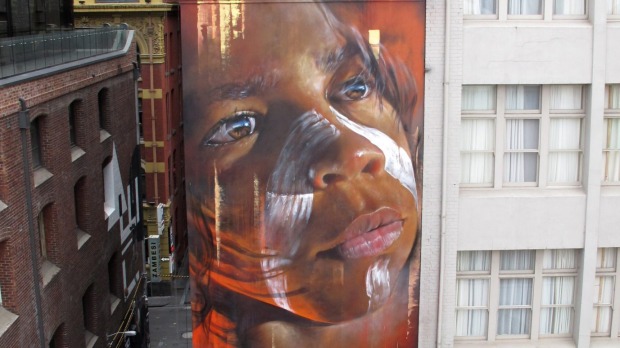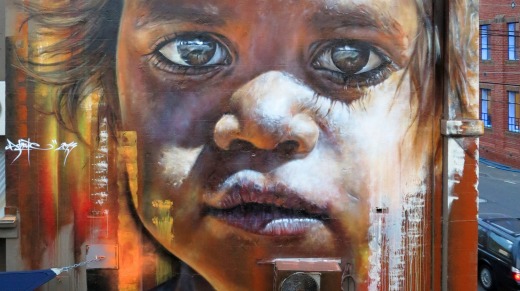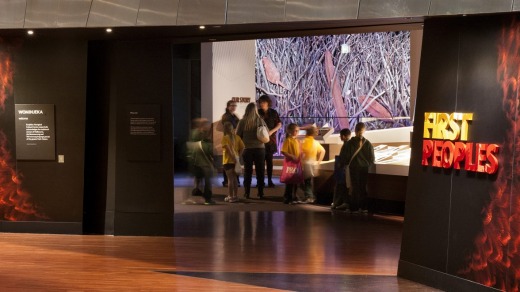
My day started with a Diprotodon's tooth, ended with a chargrilled kangaroo sirloin, and turned everything I thought I knew about Aboriginal culture on its head.
"Look closely at the markings on the tooth," says Caroline Martin, manager of Bunjilaka Aboriginal Cultural Centre at Melbourne Museum, pointing to the finger-like tooth inside the glass cabinet. "Those lines are Aboriginal engravings." Then Martin explains that the hippopotamus-sized Diprotodon, the largest marsupial known, became extinct about 45,000 years ago.
The possibility that these prehistoric creatures coexisted with Australia's first people gives a new perspective. Scientists are still debating the age of Aboriginal culture in Australia; 40,000 years, 50,000 years? "Up to 60,000 years," says Martin, reading my mind. "That's at least 2000 generations." Considering that descendants of the First Fleet would be lucky to count back 10 generations, this is mind boggling. "Our people have had a long time to develop a rich and sophisticated culture," says Martin, a Boon Wurrung woman, one of the two groups that are the traditional owners of the lands around Melbourne.

"No dots down here," says Martin, leading me into the Birrarung gallery, reminding me that dot paintings are indicative of Western Desert artists. Looking at the fine lines, sculptures, digital storytelling and works on canvas by Victorian Aboriginal artists I get it – southern mobs do things differently.
"Koorie culture is a sophisticated, evolving, living culture," says Martin, at the entrance to First Peoples, the largest exhibition to focus on Aboriginal Victoria. Opened two years ago, First Peoples was announced as the Overall Winner at the 2014 American Alliance of Museums for Excellence in Exhibitions.
Inside are examples of "messenger sticks", once used to relay information between Victoria's 40 language groups, eel nets, representing the world's oldest aquaculture systems and "kopi" caps worn during mourning. Among the 600 artifacts there are also spinning tops and marngrook, used for ball games. Perhaps the most moving exhibit is a possum cloak from the Murray River area, one of only five left in the world.

"It gets cold in south-eastern Australia," says Martin. "So when a baby was born it was wrapped in a possum skin pelt." These pelts are covered in symbols detailing the child's clan, country and place in the community. Worn day and night, the cloak grew as the child grew, with more pelts and stories added year-by year, panel by panel. "When the person died they were buried in it," says Martin. "Wrapped in their country." Today, the art is being revitalised as a contemporary design practice to help sustain culture for younger generations (the possum pelts come from New Zealand, where they are a pest).
More examples of this contemporary vitality is on Melbourne's laneways, where street artist Adnate has painted a series of Aboriginal portraits. From a 23-metre high mural of an indigenous boy on Hosier Lane to the intense gaze of a child's face painted with ceremonial markings, Adnate's murals brings the strength and diversity of Aboriginal culture to the streets.
"When I paint portraits of Indigenous Australians I'm trying to communicate a very strong message," says Adnate.

"Many Indigenous people have told me that they get a lot of pride from these paintings and it enlightens them, but to me, they are reclaiming the space that was taken from them."
Adnate tries to consider the environment and to compose each piece of work into it. "For the Hosier Lane wall, I felt it was important to raise awareness of significant sites for the nation's first people," he says. "The gaze of this particular portrait looks straight towards Birrarung Marr, a culturally significant site for the Indigenous people, being the "river of mist".
From here I head to Charcoal Lane in Fitzroy, a Mission Australia social enterprise restaurant providing training and opportunities for Aboriginal youth. In an 1854 building, once home to the Victorian Aboriginal Health Service, this thriving restaurant is led by executive chef Greg Hampton. "Many of the kids were disconnected from their culture," he says. "Through cooking and sourcing native ingredients we are bringing back their connection." Blending native Australian ingredients with contemporary cooking techniques the enterprise boasts a 95 per cent success rate of trainees finding employment in hospitality.
While the food is outstanding – wild foraged mushroom consomme, beetroot and lemon tea cured salmon, chargrilled kangaroo sirloin, chocolate and wattle seed pudding – it's the shy smiles and gentle grace, the careful, yet confident placing of plates, and the palpable sense of pride I'll remember. In one day I feel I've collected a pocketful of message sticks; to share with others, to pass on the story about the diversity of Aboriginal culture and how is continues to evolve. As Martin says: "It's our culture, but your history too."
Qantas flies daily from Sydney to Melbourne, see qantas.com.au
The Olsen Hotel, part of the Art Series Hotel Group, offers five-star suites infused with the works of Australian landscape artist Dr John Olsen. Prices from $219 for a studio suite, 637-641 Chapel Street, South Yarra; see artserieshotels.com.au.
Bunilajaka Aboriginal Cultural Centre, Melbourne Museum, 11 Nicholson Street, Carlton. Open daily 10am-5pm. Adults $12, children and concession free. Phone 13 11 02; see museumvictoria.com.au.
Charcoal Lane, 136 Gertrude Street, Fitzroy, open Tuesday-Saturday 10.30am-9pm. Phone (03) 9235 9200, see charcoallane.com.au.